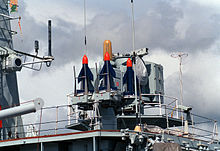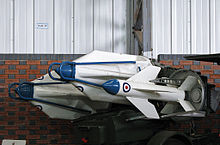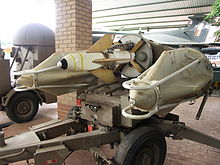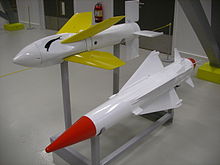- Sea Cat
-
This article is about the missile. For the ferry operator, see SeaCat.
Sea Cat 
Sea Cat GWS-20 series missileType Surface-to-air missile Place of origin United Kingdom Service history In service 1962– Used by UK, Argentina, Australia, Brazil, Chile, South Africa, Sweden, Zimbabwe and New Zealand Wars 1971 Indo-Pakistani War (Tigercat SSM deployed to fronts by India)
Falklands War
South African Border WarProduction history Manufacturer Short Brothers Variants Fire Control (see text) Specifications Weight 68 kg Length 1.48 m Diameter 0.22 m Warhead 40 lb (18 kg) Continuous Rod Detonation
mechanismproximity Engine 2 stage motor Wingspan 0.70 m Operational
range500–5000+ m Speed Mach 0.8 Guidance
systemCLOS & radio link (see text) Steering
systemcontrol surfaces Launch
platformShip Sea Cat was a British short-range surface to air missile system intended to replace the ubiquitous Bofors 40 mm gun aboard warships of all sizes. It was the world's first operational shipboard point-defence missile system and was designed so that the Bofors guns could be replaced with minimum modification to the recipient vessel using (originally) existing fire-control systems. A mobile land-based version of the system was known as Tigercat.
Contents
History
Sea Cat was designed by Short Brothers of Belfast for use against fast jet aircraft that were proving to be too difficult for the WWII-era Bofors guns to successfully intercept. The missile itself was based on the Shorts Green Light prototype, itself a development of the Australian Malkara anti-tank missile. It replaced the Orange Nell development programme for a lighter weapon than the enormous Sea Slug missile.
Design Features
Sea Cat is a small, subsonic missile powered by a two-stage solid fuel rocket motor. It is steered in flight by four swept, cruciformly arranged wings and is stabilised by four small tail fins. It is guided by Command Line-Of-Sight (CLOS) via a radio-link; i.e. flight commands are transmitted to it from a remote operator with both the missile and target in sight.
Variants
All Sea Cat variants used a common 4-rail, manually-loaded, trainable launcher that incorporated the antennae for the radio command link. All that was required to fit the system to a ship was the installation of a launcher, the provision of a missile handling room and a suitable guidance system. Sea Cat was widely used in NATO and Commonwealth navies that purchased British equipment and has been used with a wide array of guidance systems. The four systems used by the Royal Navy are described below.
GWS-20
This was the initial system, and was intended to replace the twin 40 mm Bofors Mark V gun and its associated fire-control systems. The original director was based on the STD (Simple Tachymetric Director) and was entirely visual in operation. The target was acquired visually with the missile being guided, via a radio link, by the operator inputting commands on a joystick. Flares on the missile's tail fins aided identifying the missile. The more advanced CRBF (Close Range Blind Fire) director equipped with spin-scanning radar Type 262 for automatic target tracking could also be used.
GWS-20 was trialled on board the Daring class destroyer, and was subsequently removed. It was carried in active service by, (amongst others) Fearless class landing ships and Type 81 Tribal, updated Type 12 Whitby, Type 12I Rothesay and (originally) County class escorts. It was originally intended that all C class destroyers should receive it and the class were prepared accordingly. In the event only HMS Cavalier and HMS Caprice received it, in 1966 refits.
GWS-20 saw active service in the Falklands war onboard the Fearless class and the Rothesay frigates HMS Plymouth and HMS Yarmouth, who retained the GWS-20 director when upgraded to GWS-22.
GWS-21
Sea Cat launcher and GWS-21 director on HMNZS Wellington, a Leander-class frigate. Notice the operator's CCTV camera on the director and the orange dome, housing the antenna for transmitting commands to the missile
GWS-21 was the Sea Cat system associated with a modified Close Range Blind Fire analogue fire control director (CRBFD) with Type 262 radar. This offered manual radar-assisted (Dark Fire) tracking and guidance modes as well as 'eyeball' visual modes. It was carried as the design anti-aircraft weapon of the Type 81 Tribal class frigate and on the first 4 County class destroyers.
GWS-22
GWS-22 was the Sea Cat system associated with the full MRS-3 fire control director with Type 903 radar and was the first ACLOS-capable (Automatic, Command Line-Of-Sight) Sea Cat. It was fitted to most of the Leander, Rothesay and County class escorts as they were refitted and modified in the 1970s, as well as the aircraft carrier HMS Hermes. It could operate in automatic radar-guided (Blindfire), manual radar-guided, manual CCTV-guided or, in an emergency, 'eyeball' guided modes. It saw active service in the Falklands onboard all these classes.
GWS-24
The final Royal Navy Sea Cat variant, this used the Italian Alenia Orion RTN-10x fire control system with Type 912 radar and was fitted only to the Type 21 frigate. This variant saw active service in the Falklands.
Tigercat
A land-based mobile version of Sea Cat based on a 3-round, trailer-mounted launcher towed by a Land Rover, and a second trailer carrying the fire control equipment. Tigercat was used exclusively within HM Forces by No.48 Squadron of the RAF Regiment between 1967 and 1978, being replaced in service by Rapier. Tigercat ware also operated by Argentina, India, Iran, Jordan, South Africa[1] and Qatar. Argentina deployed it operationally during the Falklands conflict. No kills were achieved and 7 units were captured by British forces.
Service
Sea Cat became obsolete due to increasing aircraft speed and the introduction of supersonic, sea-skimming anti-ship missiles. In these cases the subsonic, manually guided Sea Cat was totally unsuited to all but head-on interceptions and only with adequate warning.
Despite being obsolete, Sea Cat was still widely fielded by the Royal Navy during the Falklands war. Indeed, it was the sole anti-aircraft defence of many ships. However, unlike the modern and more complex Sea Dart and Sea Wolf systems, Sea Cat rarely misfired or refused to respond, in even the harshest conditions. It was capable of sustained action which compensated for its lack of speed, range, and accuracy, and more importantly, it was available in large numbers.
One confirmed "kill" of an Argentine aircraft is directly attributed to this missile from over 80 launches, when on the 25 May HMS Yarmouth shot down an A4C Skyhawk (C-319USN pic) flown by Teniente Tomás Lucero. Lucero ejected and was recovered by HMS Fearless.[2]
After the Falklands conflict, a radical and urgent re-appraisal of anti-aircraft weaponry was undertaken by the Royal Navy. This saw Sea Cat rapidly removed from service and replaced by modern weapons systems such as Goalkeeper CIWS, more modern 20 mm and 30 mm anti-aircraft guns, and new escorts carrying the Sea Wolf missile, including the vertical launch version.
The missiles were fitted to the four Swedish Östergötland-class destroyers, replacing three Bofors L/70 guns (a more modern and heavier variant than the Royal Navy's L/60) with a single launcher on each ship. The Östergötland-class destroyers of late 1950s origin were retired in the early 1980s.
Sea Cat was mounted on all six "River"-class destroyer escorts of the Royal Australian Navy and was removed from service when the final ship of this class was decommissioned in the late 1990s. In their final variant, fire control was provided by a GWS-21 guidance system supported by a Mk 44 fire control computer. Secondary firing positions based on visual tracking of the target through binoculars mounted on a syncro-feedback mount was also available. HMAS Torrens was the final ship to live fire the system prior to its removal from service, and this was also the only time three missiles were on the launcher and fired in sequence, resulting in one miss and two hits on towed targets.
Operators
- Argentine Army
- Argentine Navy, 2 Sea Cat quad launchers on cruiser ARA General Belgrano installed in 1967 [3]
- Argentine Marines, used Tigercat launchers ( deployed during Falklands War ) now replaced with RBS 70
- Indian Army - Tigercat
- Indian Navy - Seacat
- Islamic Republic of Iran Navy - Seacat
- Islamic Republic of Iran Army - Tigercat
- Military of Qatar - Tigercat
- South African Army - Tigercat
- Royal Air Force - Tigercat
- Royal Navy - Seacat
- Navy of Venezuela
- Army of Zimbabwe - Tigercat
See also
- Rainbow Codes
- Bomb Alley video Lt Tomas Lucero rescued by HMS Fearless after being shot down by a Sea Cat fired from HMS Yarmouth
References
- ^ "The Airforce - Weapons". http://www.saairforce.co.za/the-airforce/weapons/88/hilda-tigercat-sam. Retrieved 2008-07-18.
- ^ Falklands the Air War. Arms & Armour Press. p. 112. ISBN 0-85368-842-7.
- ^ Crucero "General Belgrano" C4 - 1951
- Naval Armament, Doug Richardson, Jane's Publishing, 1981, ISBN 0-531-03738-X
- Modern Combat Ships 5; Type 21, Captain John Lippiett RN, Ian Allan, 1990, ISBN 0-7110-1903-7
Guided missiles of the United Kingdom Air-to-air Air-to-surface Surface-to-air Bloodhound · Blowpipe · Javelin · Rapier · Sea Cat · Sea Dart · Sea Slug · Sea Viper · Sea Wolf · Starburst · Starstreak · Tigercat · Thunderbird
Surface-to-surface Nuclear Blue Steel · Blue Streak · Blue Water · Green Cheese
1 Anglo-French 2 Anglo-Australian Categories:- Cold War surface-to-air missiles of the United Kingdom
- Naval surface-to-air missiles
- Falklands War guided missiles
Wikimedia Foundation. 2010.




